Leaving an Impression
The campus art collection, much of it carefully chosen by the Vaughns, is a nod to the value of a cultural education
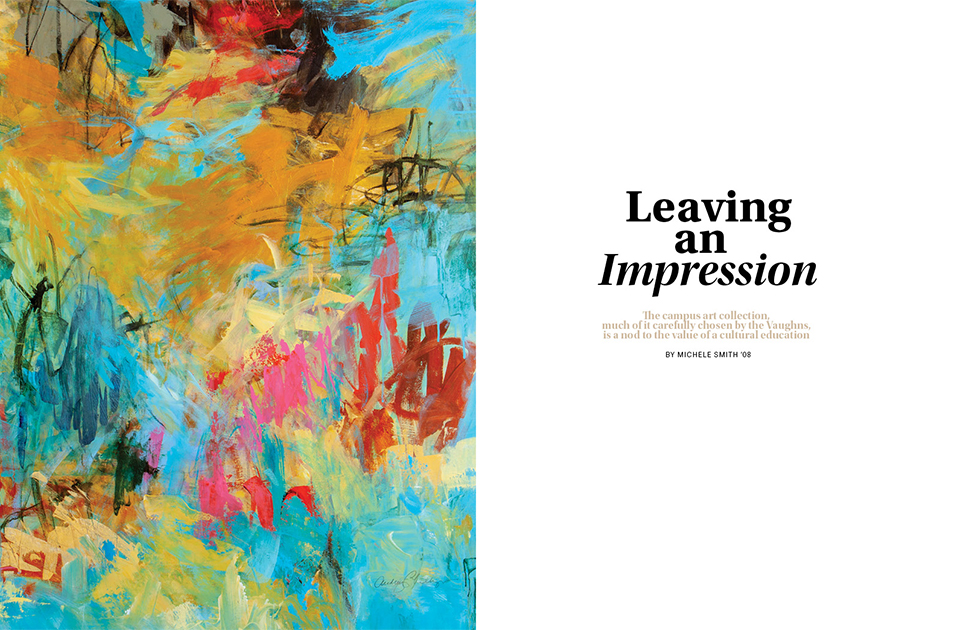 "Suspended” by Audrey Phillips hangs in the Southard Family Building.
"Suspended” by Audrey Phillips hangs in the Southard Family Building.
By Michele Smith ’08
The legacy of President Ronald Vaughn and his wife, Renée, extends beyond brick and mortar, academics and well-manicured lawns into an incredible daily life experience that is nurtured and inspired through art. Soaring sculptures in beautiful parks, open exhibitions in the renowned Scarfone/Hartley Gallery and hundreds of free programs and performances in multiple cultural spaces are easily and openly enjoyed by the campus community and the public. Every medium of arts education has a home in the Ferman Center of the Arts and R.K. Bailey Art Studios.
What many do not realize is that quietly and with delight, the Vaughns have infused artwork into many spaces around campus used and appreciated exclusively by students, faculty and staff.
For the Vaughns, art collecting is organic and serendipitous. Often, they will be out, without any agenda, when one or the other spots a piece that makes them pause in awe. Then a treasure hunt begins as they work together to identify the artist, establish relationships and perhaps even procure whole bodies of work to serve a specific purpose on campus.
Over the years, the couple has gathered an extensive collection of hundreds of paintings, photographs and sculptures, turning residence halls, athletic venues and academic buildings into de facto galleries.
Renée Vaughn honed her arts pedigree as the city’s director of arts and cultural affairs under Mayor Dick Greco ’56. Her work helped establish the public art fund. Initially, the fund was resisted by developers as an unnecessary expense, she said, but over the years, public art has become embraced by the industry.
The Vaughns hope the installation of quality, original art at UT supports the cultural evolution of indoor environments, too.
With each new building at UT, art has been as integral to the development process as massing studies and site assessments. Selected artworks are factored early into architectural renderings. Contractors plan recessed lighting for built-in display cases like in Jenkins Hall and consider installation logistics, like for the two-story mural currently in design for the Grand Center, opening this year.
Acquiring work for a specific spot in the University adds meaning to the adventure in finding it and context for what the Vaughns want the work to accomplish. Much of the visual art on campus has been chosen to bring joy, vibrancy or wonder into rigorous academic rooms.
“The work is uplifting and happy, and you need some of that in your work life and your learning life,” President Vaughn said.
Renée Vaughn added that “whimsy” is an element that is “embedded in our appreciation of art.”
The residence halls welcome students home with artwork that beautifies and inspires expansive thought and action. For instance, Jenkins Hall has an intentionally global theme that honors UT’s diverse student body and helps develop cultural understanding.
“We want students to realize they are working in a world without walls,” President Vaughn said.
On the ground floor of Jenkins Hall, there are two areas with a collection of 140 photographs taken by students while traveling internationally. The images were organized by Oxford Exchange Design into galleries. Beautiful cultural artifacts, maps and international crafts are on display, offering another dimension to the multinational focus. In the stairwell, the six languages of the United Nations identify every floor.
Just off the elevators are famous quotations painted large on the walls that remind students to think big.
The Vaughns’ business acumen appreciates that original artwork is an investment that will benefit the University. But the primary impetus for collecting has been about quality of life for students. Additionally, the Vaughns have searched out mostly Florida artists to provide opportunities and uplift the lives of local talent. While doing so, many of the artists have become friends.
Every year on the anniversary of her opening, artist Audrey Phillips reaches out to express appreciation for the life-changing opportunity to create a private gallery of 54 pieces displayed throughout the Southard Family Building.
“It was clear they didn’t just want to decorate walls,” Phillips said of the Vaughns. “They are collectors. They love art, and they want students to have original art surrounding them.”
She continued: “It is a life-changing investment for an artist. ... To be tied to the UT collection with its reputation is important. It’s a highlighted part of my story now.”
There has been great care in gathering work to fit the theme of each space, but not every piece has a name or an identifying placard. The naturalness of the work existing in the periphery helps students acclimate to beautifully appointed spaces in an almost mundane way, even when the art is rare and valuable.
While it’s difficult to pick which pieces best represent the University’s vast and varied collection, we asked the Vaughns about some of their favorites, the curation process and the collection’s lasting impression.
![]()
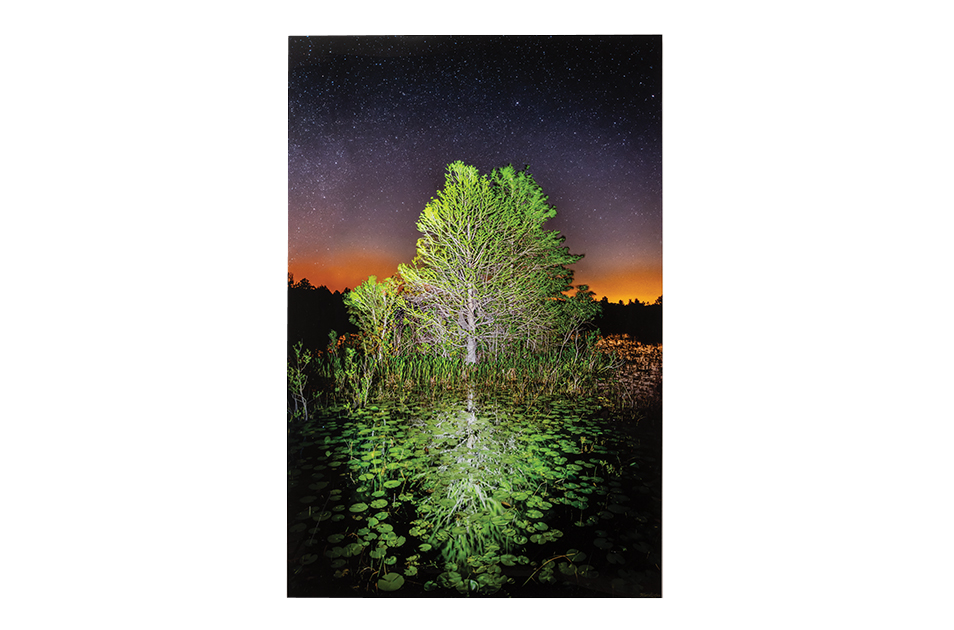 Matt Stock’s photographs hang in Palm Apartments and the Daly Innovation and Collaboration Building. Photo by Alex McKnight
Matt Stock’s photographs hang in Palm Apartments and the Daly Innovation and Collaboration Building. Photo by Alex McKnight
Matt Stock
Matt Stock applies his arts education from Savannah College of Art and Design and his love of science to craft his signature style of photographs. In his process, Stock and his team illuminate a scene by optimizing natural light sources, including the moon and stars, and supplementing them with specialized lighting tools. The process may take many hours and hundreds of exposures to capture the right moments. Then, Stock digitally knits together elements from each exposure captured in real time and on location into a single composition where light takes center stage.
Stock’s work is the showcase of the lobby of Palm Apartments, home to approximately 660 students. Stock’s vivid images of nature immaculately illuminated are the perfect complement to the wood-planked walls. The effect is a calming, natural space. Stock’s art also is featured elsewhere on campus, including on the ground floor of the Daly Innovation and Collaboration Building.
The Vaughns discovered Stock, a Miami artist, at a small South Florida gallery and enthusiastically tracked him down. “He creates the lighting,” President Vaughn shared. “He sets the stage for each photo production and then puts it together in the most incredible ways. It’s just amazing.”
![]()
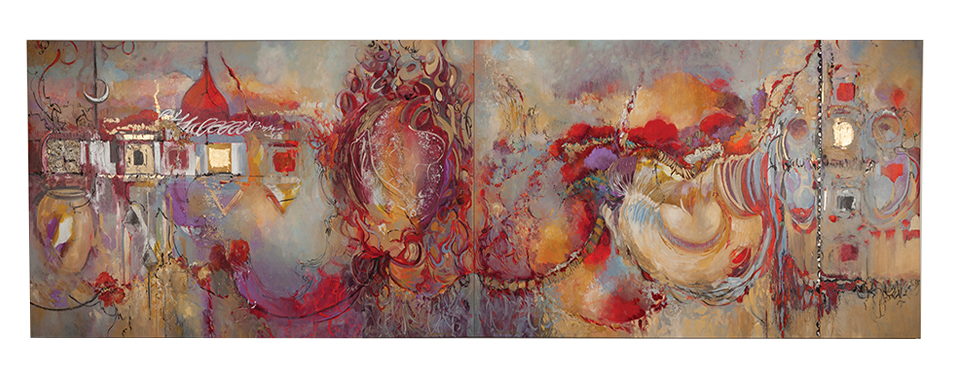 Barbara Krupp’s paintings can be found on the Health side of the Jenkins Health and Technology Building. Photo by Alex McKnight
Barbara Krupp’s paintings can be found on the Health side of the Jenkins Health and Technology Building. Photo by Alex McKnight
Barbara Krupp
The Vaughns were strolling through Sarasota shops while on a trip to plan UT’s annual board retreat when, “through the window of Dabbert Gallery, we saw this work called ‘The Beauty of Wisdom,’ which resonates with the theme of the University,” recalled Renée Vaughn.
They promptly started a commission with artist Barbara Krupp for the Health side of the Jenkins Health and Technology Building. “We were the first time she had ever taken a commission. But we needed a piece that was almost 15 feet, and you don’t find that size of work on the shelf at an art gallery,” President Vaughn said.
Krupp is a self-taught artist who was once a radiology technician. Her background fit perfectly for the commission for the building that would house UT’s nursing and physician assistant medicine programs. The finished piece, “Breath of Immortality,” above, masterfully incorporates school colors and the Plant Hall minarets with abstract representations of organs on a dynamic palette of violet, blues, reds and orange. The combined feeling is of life taking a dynamic shape.
In all, UT acquired 53 pieces from Krupp. Her works counterbalance the academic environments, offering respite from the intellectual rigor.
Many of Krupp’s pieces hint at anatomy. The patterns of paint splashes resemble neurons and blood vessels. The depth of field between layers implies pulsing movement. Even though each work has a title, students and professors often rename the pieces after coming up with their own interpretations of the abstract work.
![]()
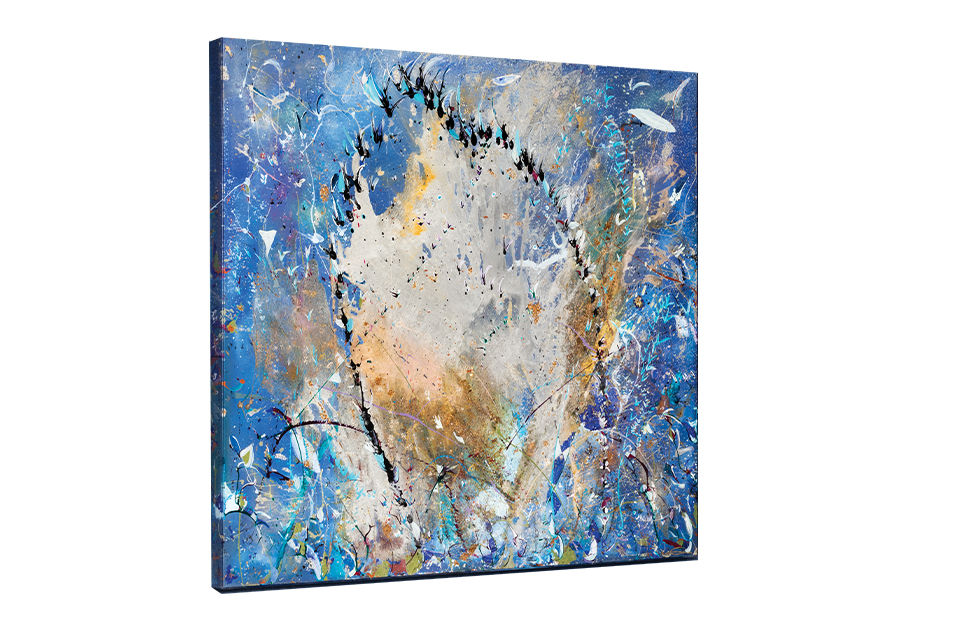 Sara Conca’s artwork hangs on the Technology side of the Jenkins Health and Technology Building and the science research labs. Photo by Alex McKnight
Sara Conca’s artwork hangs on the Technology side of the Jenkins Health and Technology Building and the science research labs. Photo by Alex McKnight
Sara Conca
Excitement emerges when President Vaughn speaks of artist Sara Conca’s work. He describes her art as futuristic and otherworldly, and he marvels at her process. “She works from the back of the piece of art; the glass is face down, and she’s putting in elements, little bits of brass, gold or silver,” he described.
Conca studied sculpture at Ateliers d’Art de Saint-Maur-des-Fossés in Paris and later was an assistant of the critically lauded contemporary artist Purvis Young. Conca is a plein air artist, and all work hanging in the Technology building, like “Heavenly Union,” left, was created in layers while she was outdoors, often by a river or lake. The Vaughns were taken by the spiritual nature of the work and acquired 87 pieces to adorn the Technology building and other buildings.
“When it came to the Technology building, we became very focused on the white space that we could complement with artwork,” Renée Vaughn said. “(Conca’s) work complements the activity of the technical space and brings in color.”
“It animates the space, brings it to life,” President Vaughn added.
![]()
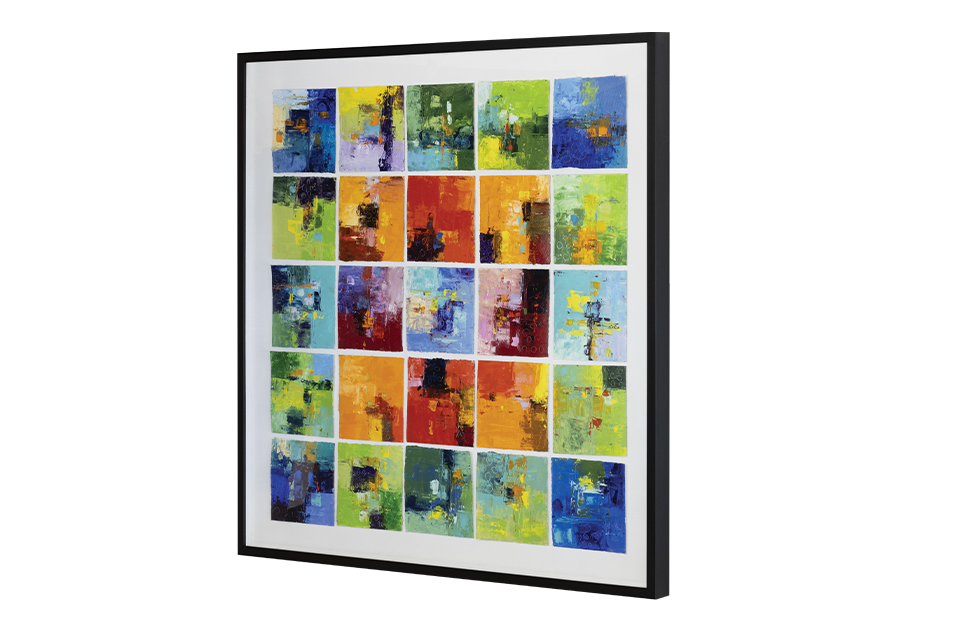 Ummarid “Tony” Eitharong’s paintings can be found in Smiley Hall and new Grand Center. Photo by Alex McKnight
Ummarid “Tony” Eitharong’s paintings can be found in Smiley Hall and new Grand Center. Photo by Alex McKnight
Ummarid “Tony” Eitharong
Smiley Hall is a private residential space for students that’s enlivened by the playful works of contemporary artist Ummarid “Tony” Eitharong.
Renée Vaughn discovered Eitharong years ago while overseeing the city of Tampa’s involvement in the Gasparilla Festival of the Arts. She served on a jury to identify emerging artists and learned about Eitharong, a self-taught artist from Thailand. Now his work is featured in public and private collections in the U.S. and Europe, including at UT.
In Smiley Hall, two dozen abstract acrylic pieces enhance both floors with creamy dollops of bold color and blocks of mixed media. Paintings pair geometric shapes with interrupting lines and splashes of purple, orange and red. Brush strokes are not clear in most pieces, hinting at perhaps the use of a palette knife to precisely apply and spread color.
Eitharong is working on a commissioned 18-foot by 30-foot mural for the new Grand Center. The five-paneled, colorful piece entitled “Urban Landscape” will embody the concepts of diversity and harmonious community.
![]()
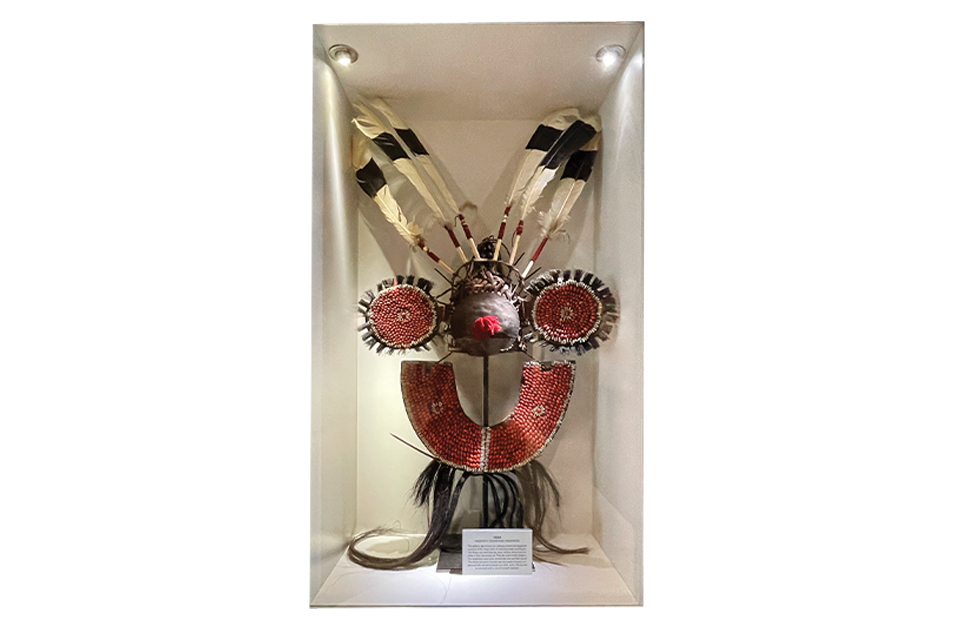 The art in Jenkins Hall has an international theme. This headdress is from India. Photo courtesy of the Scarfone/Hartley Gallery archive
The art in Jenkins Hall has an international theme. This headdress is from India. Photo courtesy of the Scarfone/Hartley Gallery archive
Indian Headdress
Illuminated in the north wall of the lobby of Jenkins Hall is a stunning ceremonial headdress of a warrior from the Tangkhul people of Nagaland, in northeast India.
The headdress consists of a tapering bonnet of coarse cane work. The middle metal disc is adorned with a red fiber tassel and is set between two wooden disc-shaped projections. Below is a semi-circular jaw piece also made of wood and adorned with red abrus beans and grey Job's-tears seed beads, with tufts of black animal hair attached at the bottom. It is crowned with hornbill feathers arranged in a fan.
Other pieces nearby in the space include a beautifully beaded baby carrier from Borneo and an embellished vest adorned with coins and buttons from Afghanistan. Another case houses works by internationally acclaimed artist Marlene Rose, whose studio is in Clearwater.
“Marlene gathered up about 20 glass sculptures, and we staged them around (President Vaughn’s) office,” Renée Vaughn recalled of the process of choosing pieces to be showcased in Jenkins Hall.
![]()
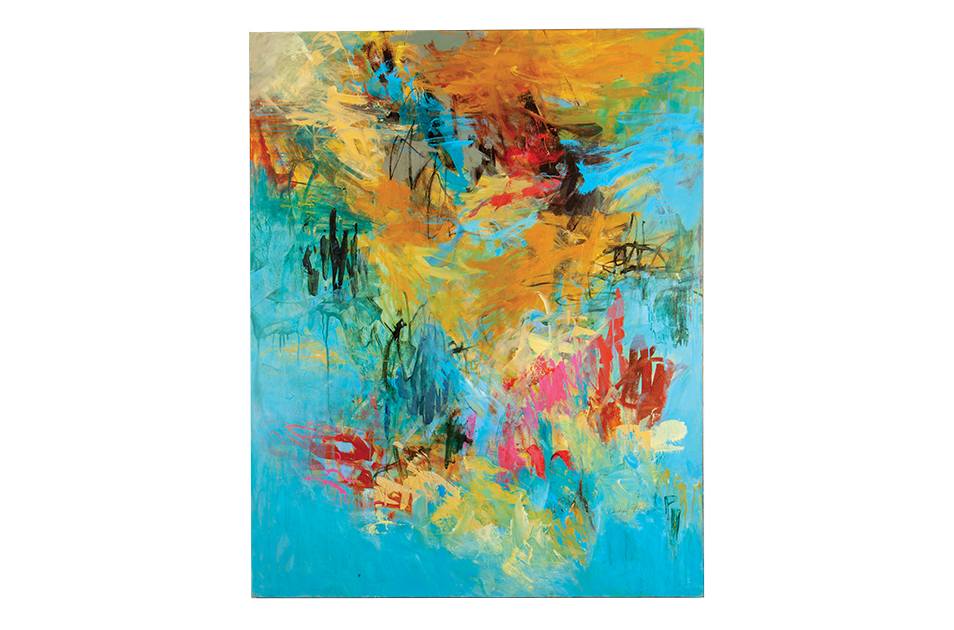 Audrey Phillips’ paintings can be found in the Southard Family Building. Photo courtesy of the Beck Group
Audrey Phillips’ paintings can be found in the Southard Family Building. Photo courtesy of the Beck Group
Audrey Phillips
“Suspended” may remind one of an abstract reflection of a person on water, capturing the best and brightest essence dancing on the surface, with optimistic blue depths drawing you in. It’s at once comforting, playful and joyous.
The Vaughns spotted “Suspended” artist Audrey Phillips’ work in the window of the Baisden Gallery, a small Tampa gallery once located near campus. “We just stopped in our tracks,” recalled Renée Vaughn. “Her work spoke to us. When I looked at her work, I could see students identifying with it.”
The couple later learned that Phillips used art as a form of healing to move through a traumatic loss, transmuting heavy emotions into buoyant and vibrant expressions of hope.
In total, UT acquired 54 bright, abstract acrylic paintings to enliven both floors of the Southard Family Building.
Over this process, the Vaughns found that Phillips had an existing connection to the University. “We discovered that she had been interacting with our students in a guest artists program. Over the years she had been sharing her work and skill with our students and enjoyed herself,” President Vaughn said
![]()
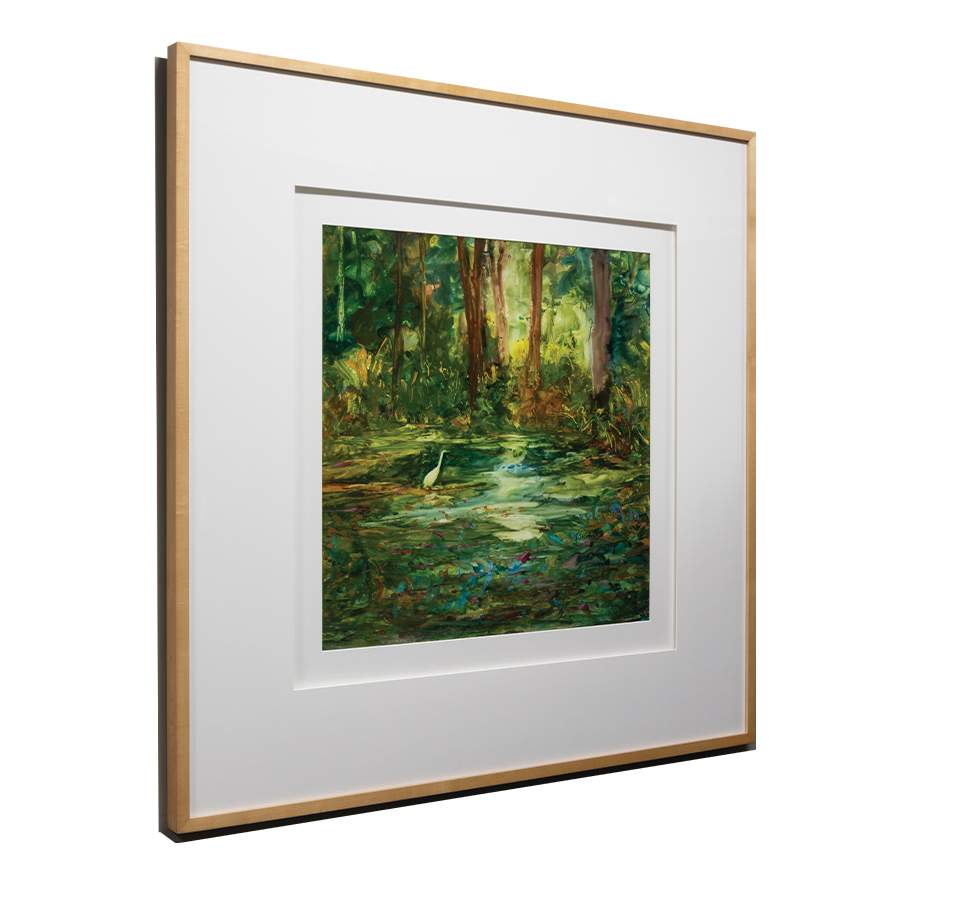 Taylor Ikin’s paintings can be found in the Daly Innovation and Collaboration Building. Photo by Alex McKnight
Taylor Ikin’s paintings can be found in the Daly Innovation and Collaboration Building. Photo by Alex McKnight
Taylor Ikin
Taylor Ikin’s watercolor paintings have been extensively collected in Tampa for years. Her work is currently displayed in public libraries, civic buildings and private residences.
She is a self-taught artist who discovered her art form later in life, experimenting with watercolor while living in the West Indies after being widowed at age 33. She enjoyed capturing the tropical landscapes and would sell her work to tourists. She remarried, and after her husband retired, they relocated to Tampa, and she shifted focus to depicting the beauty of the Hillsborough River.
Ikin’s work is often described as heartfelt and empathetic. She seeks to foster responsibility for natural spaces and promotes preservation and conversation. Her impressionistic style captures the lushness of Florida's landscape with a dreamy quality. Her work subtly compels environmental activism.
Her preferred medium is Yupo, a synthetic paper originally used in the printing industry. “It’s shiny paper, satin-like,” Renée Vaughn described. While working for the city, Renée Vaughn enjoyed studio visits with Ikin and learned about her unique process.
Much of Ikin’s work is displayed on the second floor of the Daly Innovation and Collaboration Building, bringing the natural world to exist alongside faculty offices, classrooms and student study areas.
![]()
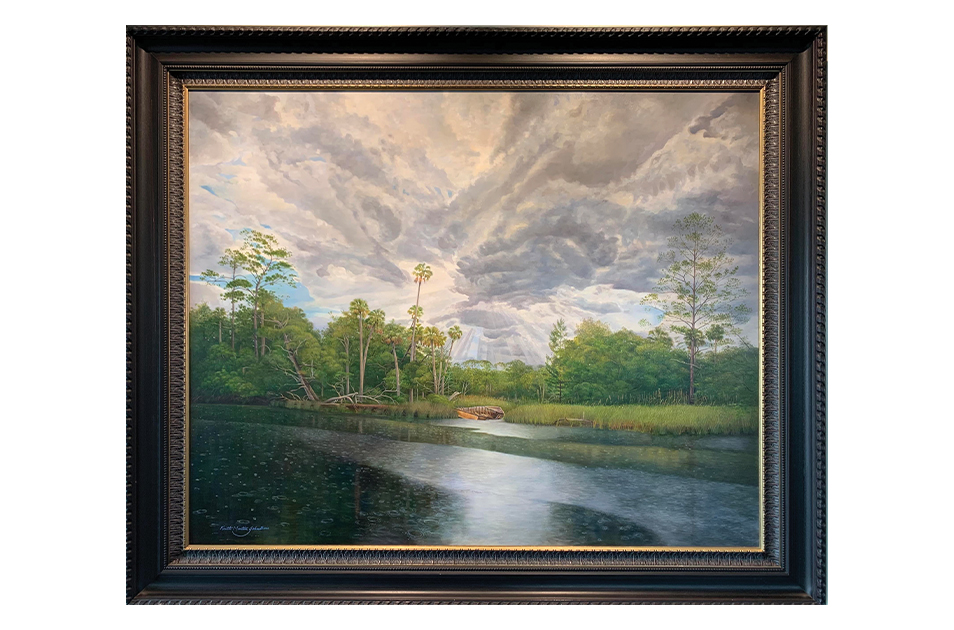 Keith Martin Johns’ “After Rain on the River” can be found in the Vaughn Center. Photo by Alex McKnight
Keith Martin Johns’ “After Rain on the River” can be found in the Vaughn Center. Photo by Alex McKnight
Keith Martin Johns
“After the Rain on the River,” is a piece on the ninth floor of the Vaughn Center. The original oil painting is contemplative and reverent. Keith Martin Johns, a Florida artist, started this commission by bringing photos to discuss a concept with the Vaughns.
“I enjoy the outdoors, the beauty of nature," said President Vaughn. “(Johns) does a great job capturing the skies. I’ve been out on the water after rain has poured, and it can be so peaceful. It’s special.”
According to President Vaughn, Johns developed the idea and painted it for 14 months. President Vaughn visited his home studio to see the work in progress and was in awe of the artist’s commitment to capturing the scene he had envisioned.
“He’s got his dining room where he’s eating every day and across the room behind open double doors was this 10-foot piece he saw every single day. Every day. As a result, the piece is filled with intricate detail if you look closely.”
A deeply spiritual man, Johns’ paintings capture the familiar culture, heritage and natural beauty of Florida while seeking to highlight the divine. He allows his own spiritual connection to flow through his work as a personal testimony. Several of his original works can be found in the Vaughn Center.
Signaling a great appreciation, Renée Vaughn shared that the couple has four of his works in their home.
![]()
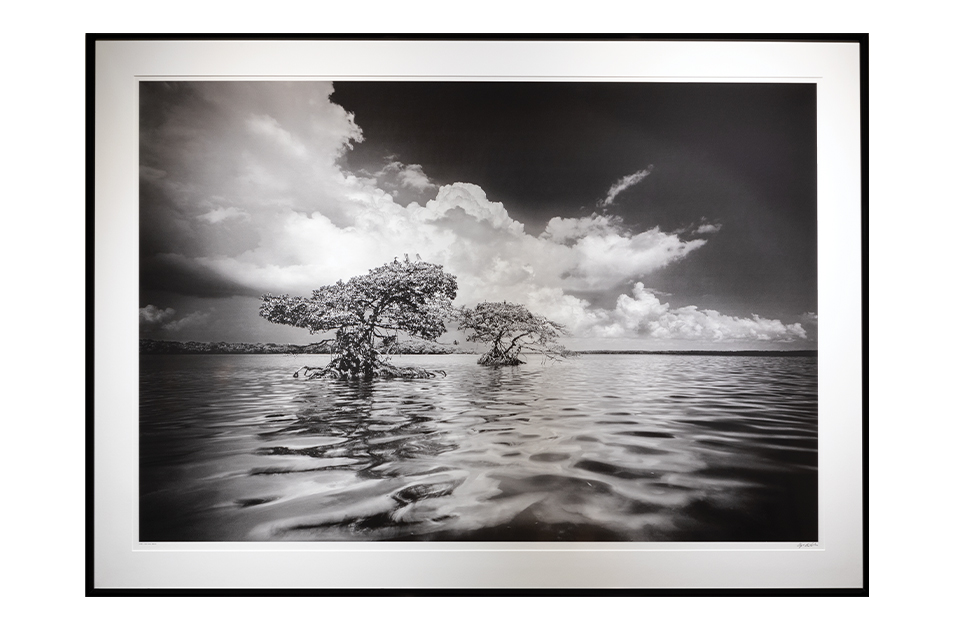 Clyde Butcher’s photography can be found in Straz Hall. Photo by Alex McKnight
Clyde Butcher’s photography can be found in Straz Hall. Photo by Alex McKnight
Clyde Butcher
Clyde Butcher is an internationally respected photographer often referred to as the Ansel Adams of Florida landscape. While Butcher’s work is important aesthetically, he hopes that it will provide a vital tool for energizing efforts to preserve wilderness and wildlife habitat.
Butcher and his wife, Niki, operate a production studio and gallery in Venice where he crafts large-scale black-and-white landscapes in silver gelatin, platinum palladium and digital mediums of photography. Most of his images are captured at their home base, Big Cypress Gallery, founded on 14 acres in Big Cypress National Preserve in southern Florida, surrounded by over a million acres of untouched wilderness.
Butcher has been known to wade waist-deep into the Florida Everglades National Park and set up his tripod in the murky water, home to all manner of swamp creatures.
“He shared about a time he was in the water wading for hours waiting for a shot, and an alligator came swimming close,” President Vaughn recalled.
“Clyde reached out and tapped him on the nose to shoo him away. Now that takes something, doesn’t it? Because you are not going to lose the shot you’ve been waiting for all day.”
Butcher’s work takes center stage in Straz Hall, which has a nature theme to the décor and artwork. Beautiful amethyst geodes sparkle inside glass encasements, and fossils add a bit of wonder. In the gathering spaces of the lobby, two of Butcher’s photographs evoke peace and introspection, beacons for connection with the self and others and the natural world that connects us all.
![]()
Campus Sculptures
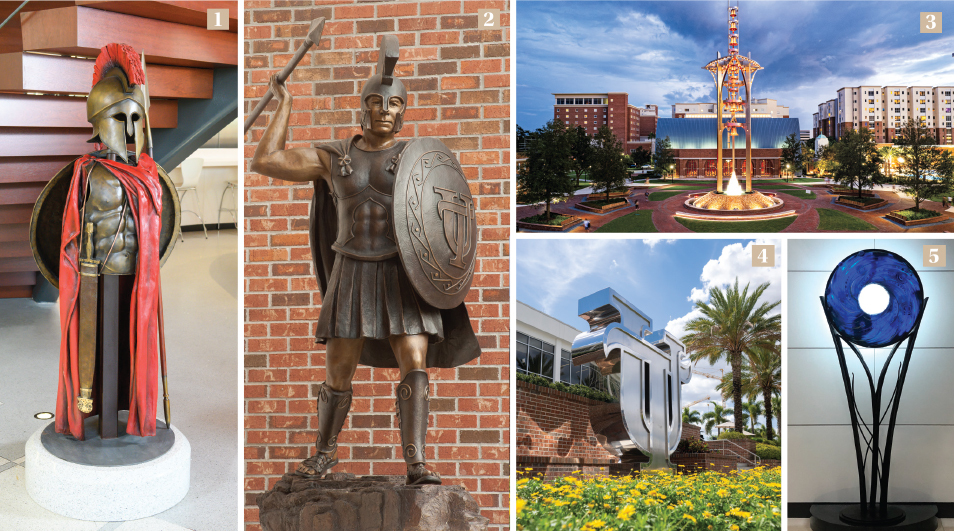
1. Even while on honeymoon, making the campus special was never far from the Vaughns’ minds. The newlywed couple was taking a stroll in the small town of Bigfork, Montana, when they spotted a clay maquette of a Spartan helmet in a shop window.
They were inspired by the find and later commissioned the artist, master sculptor Eric Thorsen, for the bronze Spartan that today stands in the Benson Alex Riseman Fitness and Recreation Center. “The Spartan armory which we commissioned — a shield, a spear, an actual cape — all of that was researched to determine the actual length of a sword and how it would look. They researched it for months before casting it and coloring it,” President Vaughn said.
2. Throughout the athletic halls, artistic details instill the fierce Spartan spirit of sport and grit that complement the campus’ emphasis on scholastic excellence. “Art adds something special for the Spartan brand,” said President Vaughn.
The two full-figure Spartan warrior sculptures standing guard in front of the Martinez Athletics Center and one inside the front doors in the Circle of Championships were crafted by Florida Artists Hall of Fame inductee W. Stanley “Sandy” Proctor of Tallahassee.
3. The Susan and John Sykes Ars Sonora, a work years in the making, has been described as a masterpiece of art and music. The Vaughns traveled with Susan and John Sykes to France to research, design and perfect the largest Ars Sonora® in the world, towering 105 feet into the sky. The finished piece is a perfectly balanced work of art that marries old-world craftsmanship and state-of-the-art technology. The metallic tower of 63 hand-crafted bronze bells, which are played by an electronic piano keyboard, is grounded by an earthen stonework base and bubbling waters on a lawn patterned after a lotus blossom mandala. Together, the design provides a rich, resonant musical experience that reverberates inspiration.
To ensure the safety and integrity of the piece during potentially destructive weather, the root system of reinforced concrete piers beneath the sculpture extends almost as deep as the bells soar high. This rooting brings to mind the phrase of Hermetic philosophy "as above, so below,” the idea that who we are on the inside will be created in the world around us.
4. The centerpiece of the Southard Family Building's riverfront plaza is a nine-foot interlocking UT sculpture, made entirely of superior marine-grade stainless steel. The piece is illuminated at night and was fabricated by Sarasota-based creator Scott Hamblin of The Resource Factory.
5. A mesmerizing blue glass sculpture adorns the Jenkins Health and Technology Building. “Next to the elevator there was a white wall ... and the space needed something vibrant,” explained Renée Vaughn. The Vaughns worked with Tampa artist Susan Gott on a plan for a rich royal blue glass mold and metalwork for the base, in total weighing over 600 pounds.
